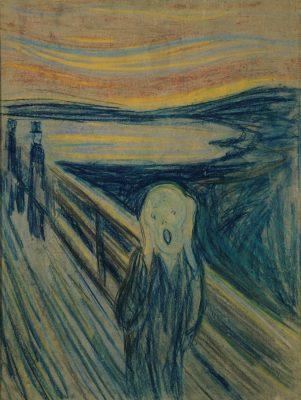 |
| Edvard Munch, The Scream, 1893-1910 |
VAN GOGH + MUNCH
9 May – 6 September 2015
The Munch Museum
Oslo, Norway
Be prepared for the art event of the year in 2015! A blockbuster exhibition, that brings together Vincent van Gogh and Edvard Munch for the first time.
Vincent van Gogh (1853-1890) and Edvard Munch (1863-1944) are two distinctive and influential artists. Both created art with a strong emotional content expressed via a personal and innovative style, and both lived troubled lives. The public and art historians alike have often compared them to each other. And there are striking parallels between their art and their artistic aims. They each represented an artistic turn towards existential and universal themes in new and expressive idioms. Yet despite these obvious common traits, which have been underscored time and again in art history and art criticism since the end of the 1800s, the more profound connections between the two artists have never been thoroughly illuminated in the context of an exhibition.
The exhibition will encompass approximately 75 paintings and 30 works on paper, including about ten comparative works by other artists. Both museums will contribute a discerning selection of major works for the exhibition, complemented by important loans from other museums and private collectors.
The exhibition Van Gogh+Munch will for the first time explore the similarities and connections between these two artists; those that immediately jump out at you as well as those that exist on a deeper level. Rather than uncritically accepting established perceptions, the exhibition will take a closer look at their artistic point of departure, the influences they were exposed to, the development in style and technique and what artistic goals they set for themselves, and in this way create a deeper understanding of why these artists are so often compared to each other.
Paris became a turning point for both artists. A confrontation with the new art trends liberated the potential they harboured within while simultaneously challenging them to formulate their own programme. Although their works may be different with regard to motif and implementation, they were both preoccupied with giving expression to the condition of modern man, and they accomplished this by pressing painterly means to the utmost: a vibrant palette, a highly stylised idiom, personal and bold brushwork and unconventional compositions are characteristic of them both. Van Gogh used crude colour contrasts in The Yellow House in order to depict the intense summer heat of southern France; Munch distorted the perspective and feeling of space in The Death Room in order to create an emotionally charged and angst-filled atmosphere.
Edvard Munch: Starry Night, 1922, Vincent van Gogh, Starry Night over the Rhône, 1888,
The Munch Museum, Oslo Musée d’Orsay, Paris
“During the brief course of his life Van Gogh did not allow his flame to be extinguished – Fire and ardour were in his brush during the few years that he consumed himself for his art – In the longer course of my life and with more money at my disposal, I had thought and desired, like he, not to allow my flame to become extinguished and with burning brush to paint until the end – ” Edvard Munch, 23 October 1933
Another noticeable trait that Munch and Van Gogh had in common was that both developed ambitious projects in which a number of pictures formed a larger whole. Munch’s most famous picture series is The Frieze of Life, which encompasses most of his major works from the 1890s with the universal themes of love, angst and death. Van Gogh developed a project he called Décoration: a series of independent pictures that gained enhanced significance when shown together. As Munch wrote: “When they were positioned together there immediately arose a resonance between them and they became totally different than when displayed individually. It became a symphony.” This fascinating structural process is represented in the exhibition with a selection of major works from Décoration and The Frieze of Life.
The exhibition will conclude with a section featuring works that the artists themselves considered significant, so that in a sense they function as an artistic testament. These works are gripping expressions of vital themes such as comfort, suffering, love and the cycle of life. Munch and Van Gogh succeeded in finding a universal and direct expression for human life. Works such as The Sick Child, The Scream, Wheatfield with Reaper and Starry Night over the Rhône underscore the kinship between the two artists on a deeper and more fundamental level.
The catalogue will contain articles related to the exhibition’s various themes, in addition to texts that treat other subjects, such as the artists’ writings and the history of the reception of their work. In addition to articles by the curators of the exhibition, well-known art historians such as Jill Lloyd, Uwe Schneede and Reinhold Heller will also contribute texts.
Period: 9 May – 6 September 2015
Place: Munch Museum
Curators: Maite van Dijk, Leo Jansen, Magne Bruteig and Jon-Ove Steihaug
Catalogue: Van Gogh+Munch
Articles by Reinhold Heller, Jill Lloyd and Uwe Schneede, among others. Editors Maite van Dijk and Magne Bruteig. Published by Mercatorfonds in collaboration with the Van Gogh Museum and the Munch Museum.
Munch Museum
The Munch Museum is a monographic art museum dedicated to the life and work of the Norwegian artist Edvard Munch. The museum has the world’s largest collection of Munch’s art – 28 000 artworks – giving the museum a unique position in providing, administering and
disseminating art, both nationally and internationally, through extensive exhibitions, research
and conservation. The collection, together with Munch’s personal effects, tools, private library and a number of photographs taken by the artist, was donated by Edvard Munch to the municipality of Oslo upon his death.
Van Gogh Museum
Van Gogh Museum maintains the world’s largest collection of the works of the world’s most popular artist – Vincent van Gogh (1853-1890), more than 200 paintings, 500 drawings, letters, completed with the art of his contemporaries – Impressionists and Postimpressionists.Each year, 1.6 million visitors come to the Van Gogh Museum, making it one of the 25 most popular museums in the world.
The exhibition Munch : Van Gogh will be on view in the Van Gogh Museum from 25 September 2015.


